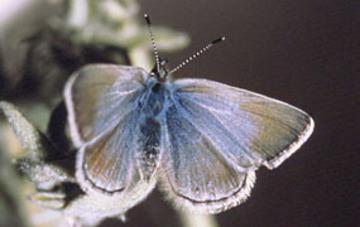Saving the endangered mission blue butterfly is a lupine-focused mission. The mission blues, which now survive only in a few places near San Francisco Bay, can’t reproduce in habitats that lack certain kinds of lupine.
The mission blue butterfly (Icaricia icarioides missionensis), a subspecies of Boisduval's blue, is an attractive insect that’s fairly easy to identify by its small size (1-1½ inch wingspan) and distinctive color. Males have dark blue or silver blue upperwings outlined in black. Females have dull brown upperwings, with only small traces of blue and occasional black spots. The underwings of both sexes are silver gray or brownish, with black speckles.
The historical range of the mission blue included much of the rocky coastal scrub and grassland habitat of Marin County and the northern San Francisco peninsula. Though once fairly common in coastal areas near the Golden Gate, the mission blue is now absent in much of its former range. There are only a few remnant populations in the San Francisco Bay vicinity.
The steep downturn in mission blue numbers that began many decades ago did not go unnoticed by wildlife biologists, public land managers, and environmental NGOs. The mission blue has been a federally listed endangered species since 1976, and recent years have brought some fairly rigorous efforts to halt and reverse the decline.
Habitat protection and improvement is the key to sound management of this species. Though the mission blue’s plight has more than one cause, habitat loss and degradation is the major negative. Over the decades, human activities, mostly related to residential and industrial development, grazing, cultivation, quarrying, ORV use, and the introduction of invasive plant species (such as European gorse, pampas grass, ice plant, broom, fennel, Monterey pine, eucalyptus, and thoroughwort) have obliterated large swaths of mission blue habitat and severely damaged much of what’s left. Now the task of rescuing the mission blue can be pretty well summed up as a matter of saving, restoring, and possibly expanding the remaining islands of suitable habitat.
Suitable habitat means plant communities that include certain varieties of lupines. Mission blue larvae (caterpillars) are very fussy eaters. They will eat only the leaves of Lindley varied lupine (Lupinus variicolor), silver lupine (Lupinus albifrons), or summer lupine (Lupinus formosus). If this food becomes unavailable in a particular locale, there will soon be no mission blues there.
The mission blue life cycle spans just one year. Nature intends that they be replaced with a new generation each year, with the new adults emerging from early March to early July when flower nectar is abundant. But the strategy cannot work if female mission blues cannot deposit their eggs onto the leaves, stems, flowers, and seedpods of the host lupines. The strategy may not work as intended either if the larvae and or pupae are destroyed by fire, eaten by rodents, run over by ATVs, or trampled by free roaming dogs.
After decades and decades of habitat loss and fragmentation, mission blues are now hanging on in about a half-dozen places -- most commonly at elevations between 700 feet and 1,200 feet -- in the San Francisco Bay area between the Marin Headlands and Pacifica. Generally, these are the locales, including the “fog belt,” in which the host lupine varieties are still found.
Much of the remaining mission blue habitat is in the Marin Headlands and Fort Baker areas of Golden Gate National Recreation Area.
The largest concentration of mission blues, once estimated to be about 18,000 individuals, is at San Bruno Mountain in northern San Mateo County. Several thousand mission blues live in the Skyline Ridge locale west of the Santa Clara Valley, which has a string of preserves managed by the Midpeninsula Regional Open Space District. Others live in McClaren Park in San Francisco County. A very small cluster, once estimated at about 500 individuals, was tallied at Twin Peaks, a San Francisco locale which has a 31-acre Twin Peaks Natural Area managed by the San Francisco Recreation and Parks Department..
The habitat protection and restoration programs conducted in behalf of the mission blue in the Marin Headlands and elsewhere in Golden Gate National Recreation Area are representative of those being carried out wherever remaining populations of this endangered species are found. Without using heavy machinery, rangers and volunteers (lots of hard-working volunteers!) remove non-native plants that threaten to shade out or crowd out lupines. Lupines and other native vegetation are replanted where necessary. Restored areas are protected from development and excessive recreational use. Programs for managing wildfires and measures for preventing harmful landslides take into account the fact that lupines require disturbed areas to reproduce and thrive.
Though mission blue numbers are unlikely to return to their historic levels, the survival of this interesting species now seems assured.
Postscript: Insects are not entitled to state endangered species listing in California. Consequently, there is no state statute that protects the mission blue butterfly.


 Support Essential Coverage of Essential Places
Support Essential Coverage of Essential Places







Comments
I am not sure where the skyline ridge population you referred to is. Nor am I aware of any populations on OSD lands. Please contact me if you can confirm the presence of MBBs at this location.
Thank you,
Ben
Ben: Summary MBB information, including references to the Skyline ridges MBB populations, can be found at the website of the Golden Gate National Parks Conservancy. I have not personally confirmed the presence of MBBs at the sites they reference, but I do consider the information source reputable.
I have been birdwatching in a field of late located in Aptos California, I have sighted the MMB here daily. Sadly it's a site that will be bulldozed and converted into retail space. Im trying to get a picture of them but they are highly elusive little buggers.